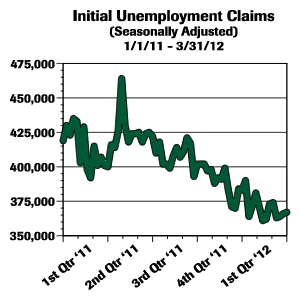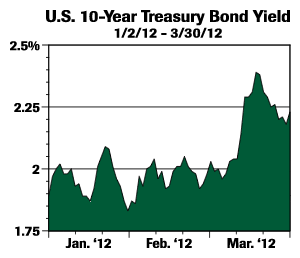2012 Q1 | Off to a Good Start
 The first quarter of 2012 was a good beginning to the year. We had solid gains in the economy, which were reflected in a strong upward movement in stock prices. In part, these advances were due to good earnings growth during the Christmas season. The market was also strengthened by forecasts for continued earnings gains for the companies in the S&P 500, not only in 2012, but also for 2013. These increases in forecasts helped to paint a brighter picture for the future of our economy. Turning to the fixed income market, interest rates were steady for most of the quarter, but moved higher at the end of March, resulting in a slight negative total return in the 10-Year Treasury (see back page). Bond results were essentially flat, with the Barclay’s Government/Credit Intermediate Bond Index up .61%. Despite (indeed, perhaps because of) the flat returns in the bond market, we are still confident in equities. In this letter, I will show you why we remain optimistic for both the economy and the financial markets.
The first quarter of 2012 was a good beginning to the year. We had solid gains in the economy, which were reflected in a strong upward movement in stock prices. In part, these advances were due to good earnings growth during the Christmas season. The market was also strengthened by forecasts for continued earnings gains for the companies in the S&P 500, not only in 2012, but also for 2013. These increases in forecasts helped to paint a brighter picture for the future of our economy. Turning to the fixed income market, interest rates were steady for most of the quarter, but moved higher at the end of March, resulting in a slight negative total return in the 10-Year Treasury (see back page). Bond results were essentially flat, with the Barclay’s Government/Credit Intermediate Bond Index up .61%. Despite (indeed, perhaps because of) the flat returns in the bond market, we are still confident in equities. In this letter, I will show you why we remain optimistic for both the economy and the financial markets.
The expansion of the economy, despite being slow and uneven, has been one of the better-kept secrets in the U.S. over the last six months. This was confirmed by the recent upward revision of the Real Gross Domestic Product for the fourth quarter to an annualized rate of +3%, a level consistent with our country’s longer-term results. The skeptical stock market of last summer and fall responded to the good news, advancing 12.66% in the first quarter as measured by the S&P 500 index, the best first-quarter advance since 1998. The financial sector, one of last year’s worst-performing sectors, reversed roles and was one of the best in the first quarter of 2012. Historically, strength in the financial sector validates strength in the stock market, as such strength confirms there is sufficient liquidity in the economy to fuel continued economic growth. Another factor contributing to share price advances was Federal Reserve Chairman Bernanke’s repeated assurances that low interest rates were here to stay, at least until the second half of 2014. Some, including those at our firm, feel that this could be a tall order if economic activity should pick up some momentum, possibly resulting in an upward spike in inflation.
There was a lot of good news in the quarter. The U.S. unemployment rate is improving as evidenced by the weekly report of new unemployment claims, which as the chart (next page) shows, were stalled between 400,000-450,000 claimants in 2011. Now, new jobless claims have fallen to under 360,000, a level usually associated with positive growth in our economy. The overall unemployment rate now stands at 8.3%, down from 9% a year ago. Long-term unemployment, which the government defines as those who have been out of work for more than 27 weeks, is still quite high. In fact, 3.5% of the workforce (or more than 40% of those unemployed) has been unemployed for more than six months. In a technology-driven economy like ours, skills need to change rapidly, and this dynamic could prevent the chronically unemployed from competing for high-paying jobs.
 A new trend we have spotted has been the resurgence of U.S. manufacturing companies. Aided by a new conciliatory relationship between union labor and management, coupled with enlightened tax policies in several industrial states, many plants are hiring a significant number of workers. In Michigan, Ohio, Indiana, and (of all places) Oklahoma, manufacturing employment is the strongest it has been in 30 years, all with overall gains of 10% or more in the last two years. Even more surprising has been the relocation of several manufacturing operations from abroad back to the United States. Caterpillar Inc. is relocating a backhoe line from Japan to Georgia, and NCR recently announced plans to move an automated teller machine production line from China to South Carolina.
A new trend we have spotted has been the resurgence of U.S. manufacturing companies. Aided by a new conciliatory relationship between union labor and management, coupled with enlightened tax policies in several industrial states, many plants are hiring a significant number of workers. In Michigan, Ohio, Indiana, and (of all places) Oklahoma, manufacturing employment is the strongest it has been in 30 years, all with overall gains of 10% or more in the last two years. Even more surprising has been the relocation of several manufacturing operations from abroad back to the United States. Caterpillar Inc. is relocating a backhoe line from Japan to Georgia, and NCR recently announced plans to move an automated teller machine production line from China to South Carolina.
In the aftermath of Mr. Obama’s “shellacking” in the midterm 2010 elections, a huge tax bill was hastily passed that allowed 100% expensing of capital expenditures made in the year 2011. The resulting surge in business investment spending witnessed the completion of many new and modernized factories. These new factories employ the most advanced technologies, which lowers cost, increases productivity, and advances U.S. competitiveness in the world markets. As 2011 ended, so did the tax break, a fact which could slow business investment and, ultimately, growth.
In March, I attended an important conference in Orlando sponsored by The Common Fund, a major not-for-profit organization providing investment advice to small and medium-sized eleemosynary institutions such as hospitals, private schools, and smaller colleges and universities that lack the scale to properly manage their endowment funds.
The conference focused on international investing, and I gained quite a bit of new information. The long term outlook for the Asian markets is quite promising. However, the Chinese are experiencing an economic “slowdown” from a 10% real growth rate to the current level of 6-7%! The Chinese economy is experiencing this growth from a significant base, as China’s $6 trillion (more or less) economy is second only to that of the United States ($15 trillion). A slowing in the Chinese growth rate could hurt many economies that have become important suppliers to China, including the United States’.
——————————————————————-
Mr. Bernanke has made it absolutely clear that a continuation of the Federal Reserve’s low interest rate policies is the primary objective of current monetary actions.
——————————————————————-
In addition, the Chinese economy is not without its own problems. Wages are rising 15-25% annually, narrowing China’s labor cost advantage over developed economies, and creating income disputes between the well-heeled Southern provinces and the less-developed Northern provinces that provide the bulk of Chinese agricultural output. These income differences are substantial between regions and are creating a class conflict that poses dangers to the political stability of the country. It may come as a surprise that China’s defense and security budget, currently about $180 billion annually (officially, at least), growing at about 13% per year, is 50% spent on internal security. Perhaps international concerns in regard to the rapid buildup of Chinese military capabilities need to be reassessed in light of these unusual spending patterns.
Also, China faces a serious demographic problem for the 2025-2035 time frame. By then, the “one child” policies of prior regimes will have resulted in serious labor shortages that will then be affecting the workforce. This fact could sharply slow growth over the coming 20 years. In addition, China’s expansion has largely ignored infrastructure needs, and it is estimated that two thirds of Chinese cities and another 300 million people in rural areas do not have safe access to drinking water. The extremely rapid growth of China may be slowed as necessary investments are made to sustain the prosperity that is coming to the country. In short, it is not yet time to panic over the inevitability of China’s economic might.
 The keynote speaker at the conference was Larry Summers, who was the leading architect of President Clinton’s economic programs, and eventually Treasury Secretary. His remarks focused on the current U.S. fiscal deficit, and he suggested that the U.S. deficit was really two deficits: a “good deficit,” and a second “bad deficit”. The “good deficit” arose from government spending to invest in the infrastructure of our economy, such as roads, bridges, transportation centers, schools, and the like. He noted that the government had seriously underinvested in our capital base and he spoke of a need to “re-roof our economic house.” These expenditures, Summers said, were like corporate capital expenditures, which are expected to produce longer-term benefits to both the economy and society.
The keynote speaker at the conference was Larry Summers, who was the leading architect of President Clinton’s economic programs, and eventually Treasury Secretary. His remarks focused on the current U.S. fiscal deficit, and he suggested that the U.S. deficit was really two deficits: a “good deficit,” and a second “bad deficit”. The “good deficit” arose from government spending to invest in the infrastructure of our economy, such as roads, bridges, transportation centers, schools, and the like. He noted that the government had seriously underinvested in our capital base and he spoke of a need to “re-roof our economic house.” These expenditures, Summers said, were like corporate capital expenditures, which are expected to produce longer-term benefits to both the economy and society.
The “bad deficit” was brought about primarily by transfer payments: unemployment compensation, food stamps, welfare payments, and questionable disability payments. He stated that the Obama administration, unable to find “shovel ready” projects for whatever reason, squandered much of the $800 billion stimulus program on transfer payments. Although well-meaning, Summers felt these payments were contributing to a growing class of people who are structurally unemployed and dependant on the state. His message was “provide the economy a modern capital base and free markets [this from a leading democratic economist] will restore prosperity, which in turn will throw off enough cash to lower the operating deficit” to an acceptable level. I would point out that this is not a pipe dream; we enjoyed a deficit-free economy under Summers and Clinton in the years 1998-2001.
——————————————————————-
In a technology-driven economy like ours, skills need to change rapidly.
——————————————————————-
While these things are mostly positive for our outlook, it would be dishonest to say that everything in the current picture is rosy. There are still a few areas of concern that we must watch carefully.
With the warm winter weather, one might expect falling energy prices, and this has certainly been the case with natural gas and coal prices, which fell 51% and 26%, respectively, since a year ago. Oil prices, however, rose during the quarter and now stand at $103 a barrel. We believe this inconsistency has occurred due to the growing tension surrounding Iran and the increasing threat of its nuclear weapons program. These factors threaten the geopolitical balance in the region, which in turn has negative implications for world oil prices, supplies, and growth rates.
A second area of concern is the ongoing difficulties being experienced in the European Union. It is now clear that the southern European countries (Italy, Spain, Portugal, France, and Greece) have a long period of austerity ahead of them to put their economic houses in order. Gerhard Schröder, former chancellor of Germany, noted in a recent speech that the German economy has avoided the perils of excessive monetary and fiscal policies by effectively lowering the competitive German wage rate by 20-30%, relative to competing industrialized countries, over the last 10 years. These policies maintained or improved the German position in world markets, at a time when much of Europe overspent on consumption, resulting in the likelihood that southern European growth will lag that of the rest of the developed world.
As our financial markets have performed well, the country has blissfully ignored its deficits, the expiring Bush tax cuts (over $500 billion), the cost of Obamacare, and a possible further reduction in its debt ratings. Certainly, we should feel a lot better than four years ago, when Bear Stearns failed on St. Patrick’s Day 2008, signaling that a major financial crisis was underway. It would hit us hard in September and October of that year with the collapse of Lehman and the near-meltdown of the world’s banking system. During that time, our nation’s private net worth fell 25%, from $60 trillion to $45 trillion, in very short order, a frightening experience even for this old dog. Half of this decline was attributable to collapsing housing and commercial real estate prices, while the other half resulted from declines in financial assets. Today, the $7.5 trillion of financial assets that were lost have, in large part, been recovered. But housing and commercial real estate remain stuck in the swamp of excess leverage, and despite very low interest rates, there are only mixed signs of recovery in this important sector of our economy.
——————————————————————-
Housing and commercial real estate remain stuck in the swamp of excess leverage.
——————————————————————-
The very strong performance of the stock market resulted in the S&P 500 achieving my year-end forecast of 1,400 as the first quarter closed. Improving prospects for earnings could justify a further 5-8% gain in share prices, to a level approaching or slightly exceeding 1,500 on the S&P 500. However, the nearly “straight up” performance of equities in the first quarter would suggest caution, as a 5% correction in equities would be more or less normal at this juncture.
Mr. Bernanke has made it absolutely clear that a continuation of the Federal Reserve’s low interest rate policies is the primary objective of current monetary actions. In Bernanke’s work, “Essays on the Great Depression,” the Chairman stated that he believed the depression of the 1930’s was extended because the Federal Reserve raised rates prematurely in 1936. This caused the economy to falter in 1937-8, delaying the permanent recovery until 1939, when federal expenditures for re-armament programs (in response to the outbreak of World War II) produced a lasting recovery. Near term, the “easy-money” policies of the Federal Reserve are clearly positive for financial assets. It is becoming increasingly obvious to me that Mr. Bernanke, for whatever reason, seems to be determined that stock prices move higher, as he has pursued policies to this end for at least the last two and a half years. We see his recent statements as further confirmation of his yearning for a stronger stock market.
So, given all the better earnings projections, good valuation prospects, the fact that unemployment is finally falling, and despite a few negatives, we remain optimistic.



